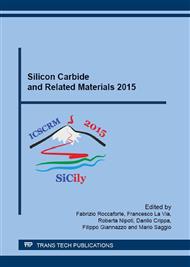p.410
p.414
p.418
p.422
p.429
p.433
p.437
p.441
p.445
4H-SiC Surface Structures and Oxidation Mechanism Revealed by Using First-Principles and Classical Molecular Dynamics Simulations
Abstract:
The 4H-SiC(000-1)C and (0001)Si surface reconstructed structures and the oxidation processes of these surfaces are investigated using a first-principles calculation method. The most stable reconstructed 4H-SiC(000-1)C and (0001)Si surfaces have p-bonded chains. In the topmost SiC bilayer, half of Si and C atoms exchange their positions and C-C or Si-Si bonds formed densely below the surfaces. When we place a SiO2 layer on the p-bonded chain (000-1)C surface, C-C bonds are formed more densely below the interface. We simulate a sequence of O2 molecules arrivals at an interface of tridymite-phase-SiO2 and 4H-SiC(000-1)C. Dissociated O atoms at the interface tended to make bonds with Si atoms. The C-C bonds in the SiC substrate break easily and a local C surface occasionally appears. We have examined how the surface structure changes through an O2 molecule exposure by using a classical molecular dynamics simulation program and confirmed the formation of C-C bonds below the surface and the interface.
Info:
Periodical:
Pages:
429-432
Citation:
Online since:
May 2016
Price:
Сopyright:
© 2016 Trans Tech Publications Ltd. All Rights Reserved
Share:
Citation:


